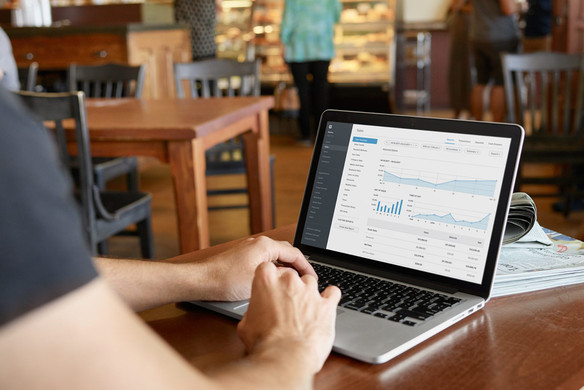Table of contents
Email marketing is the use of — you guessed it — email to promote your brand, sell products or services, and build a relationship with customers. Crafting an email marketing campaign is an opportunity to develop and deploy a message that enables your business to appeal to a specific audience.
Why should I do email marketing?
There are a lot of great reasons why email should be a vital tool in your marketing toolkit, but what makes it most appealing is that it’s one of the least expensive means of marketing. It’s also extremely effective in helping you gather data that enables you to better appeal to your customers.
With email marketing, you can measure the effectiveness of your messaging based on metrics such as open rate, clickthrough rate, and conversion. You can also look at data such as how long a person spent on your site, and what they clicked once they were there.
It’s a veritable treasure trove of information that allows you to discern which elements were and weren’t successful, allowing you to refine future messages, segment audiences, and create more compelling offers.
Compare that with direct mail marketing, for instance, which is much more expensive and often proves more difficult to measure ROI. A bump in sales following a direct mail campaign can logically be tied to the effort, but in terms of data that you can glean from the mailing and use for future advertising, there is much less unless you direct people to a specific URL, offer code, or coupon to use online or in store.
Transactional versus marketing email
To determine the types of messages you should be sending your customers (and prospective customers), you first need to understand the two main categories of email: transactional and marketing.
Transactional email
Transactional email is sent to a customer (or prospective customer) based on some action (or inaction). It aims to complete some type of transaction or process that the customer started with you, or notify your customer base of updates like system outages or a change of terms.
A confirmation is a very common transactional email. And it’s sent as a courtesy to your customers when they’ve ordered a product, signed up for a newsletter, or registered for an event.
You want to think about where transactional email makes the most sense on your customers’ journey.
Marketing email
Marketing email contains a message or content that pushes a specific commercial purpose, whether it’s an upcoming sale or event or the announcement of a new line of products. Marketing email can be sent manually or it can be automated. Either way, the timing of those sends are strategic and deliberate.
Marketing email in the United States is subject to the CAN-SPAM Act in the U.S. (and other applicable laws). Before you start sending marketing email, make sure you are familiar with all the applicable regulations. We recommend speaking with a legal expert.
8 types of marketing email
There is no one-size-fits-all for marketing email. The recipient, the occasion, and the content all influence the type of email you send. But broadly there are two categories of marketing email: manual campaigns and trigger campaigns.
Manual campaigns are done, well, manually. That is, you pull together a list of customers whom you want to message, and then email them all the same message.
If you use Square Marketing, we call these “blast campaigns.” In the Marketing section of your Dashboard, you can select the type of blast campaign you’d like to send, customize the design and copy, and determine which customer groups should receive it.
A trigger marketing campaign automatically sends email to individual users based on an action, inaction, or some other variable. These can be incredibly effective, in part because they are so personalized.
We’ve found that personalized automated email far outperforms one-off campaigns to your entire customer list. Open rates for automated offers with Square’s email marketing tool are 1.7 times higher than blast campaigns containing offers, on average. They also have a 2.3 times higher redemption rate within seven days of the email send date.
If you use Square Marketing, we call these “automated campaigns.” They’re sent to customers who meet the specific criteria for each type of email on an ongoing basis, after a one-time setup.
Now let’s look at some examples of each:
Types of manual marketing email
Informational email
Informational email does exactly that — provides information. That information might be an update on new products, an engaging piece of content you created, or a just a reminder to visit your business.
You might use this type of email for major gift-giving holidays — Christmas, Valentine’s Day, and Mother’s and Father’s Day — to give your subscribers gift ideas or special offers (both online and in store).
Newsletters
A newsletter is one way to market to prospective customers and deepen your relationship with existing customers.
You can use newsletters to highlight new products or services, upcoming events, news related to your business, content you’ve produced, and your brand’s social media accounts.
Learn how to put together a killer newsletter strategy.
Sale or promotion email
If you’re having a special sale in your store, email should be one of the primary ways that you get the word out.
You can also use email to do a promotion specifically for your customers, where you send them a coupon or discount code to use online or in the store. Customers who redeem coupons from Square spend, on average, 25 percent more on that sale than they do on their average purchase.
(Pro tip: You might even use a promotion like this to acquire new customers by making coupons shareable and posting them to Facebook.)
Event invitation
If you have a brick-and-mortar business and you want to get people into your store, you might hold special events. And email is an efficient way to invite your customers.
For example, a retailer might host a weeknight shopping party with later hours, cocktails and appetizers, and sales. A restaurant might do a special tasting menu for regular customers. A salon might have an event where it teams up with makeup artists to do makeovers.
Types of trigger marketing email
Welcome email
When people sign up for your newsletter, marketing email, or other offers, send them a message that introduces them to everything that your business has to offer. Let them know about things like exclusive discounts for subscribers so they keep receiving (and opening) your email.
Thank-you email
In many cases, your confirmation email and your thank-you email may be the same thing. You might use a thank-you email when a customer completes an action like subscribing to a newsletter or signing up for a loyalty program.
But you could also use thank-you messaging when there isn’t something to confirm. For example, you could thank your customers on your business’s anniversary each year via email (and provide a promo code or special discount). Or you might send a thank-you each time a member of your loyalty program purchases something or reaches a reward.
Reengagement email
The goal of a reengagement campaign is to get lapsed customers shopping with you again. You could do this with an email that offers a promotion or discount to the lapsed customer, or you might send an email that highlights products or services you provide.
But the bigger question is how do you know which customers are lapsed? If you have an email marketing system that integrates with your POS, you should be able to group customer email based on their purchase behaviors.
For example, a loyal customer might have made more than three visits to your store in the last month, a casual customer visited twice, and a lapsed customer hasn’t returned in six weeks.
Birthday or anniversary email
Another example of a transactional email is a birthday or anniversary message. Most birthday or anniversary email comes with some kind of offer like a discount or free gift if they show the email or use a specific bar code during their birth month.
According to data from Square’s email marketing platform, automated birthday offers generate the highest engagement. The open rate and redemption of birthday email is more than 2.5 times higher than the average across all types of email campaigns.
Email marketing tips
The goal of email marketing is, of course, to get people to open your message and respond to your call to action. But consumers (and the email systems they use) are increasingly savvy, so you need to make sure that your email strategy is, too.
Here are some tips to get your email read (and out of the spam filter):
- Don’t send too much email. Even if customers like your brand, they don’t want you to blow up their inbox, so unless they sign up for a daily newsletter, be conservative about how often you email them.
- Invest in optimization tools. Sometimes it’s not just what you say in the message, but when you send your message. For a more sophisticated operation, consider employing tools like a system that determines the best time to send your message to each subscriber.
- Avoid language that looks like spam: Customers will never even see your email if it gets caught in the spam filter, so avoid suspect subject-line wording like “click now to win a prize!” Also, while you want subscribers who opt in, you also need to make sure customers can opt out of email, and to comply with other applicable legal marketing requirements. Check this FTC guide for more information, and make sure you consult with a legal expert for your particular needs.
- Send clear, attractive messages. You don’t want to send email that sounds too good to be true (or legal), but you do want to appeal to your customers with great offers and easy-to-understand language. Square Email Marketing has beautiful, ready-to-use templates for special occasions and everyday messages.
How to start an email marketing program
When you’re ready to get started with an email marketing program, one of the first things you need to do is find an email service provider, like Square Marketing. Look for a platform that is easy to use and offers access to analytics so you can easily determine the success of your campaigns.
Next, you need to start building email lists. There are a few ways to do this:
- Through your POS
- With prompts inviting customers to subscribe to your mailing list on your website
- With calls to action on social media
Before you start reaching out to your subscriber list, you should have a clear strategy in mind, including the goals of your messages and a calendar outlining the types of email you’re going to send and when you’re planning to send them.
Provider? Check. Once you’ve got a provider, subscriber list, strategy, and calendar in place, you’re good to go. Start sending!
![]()












